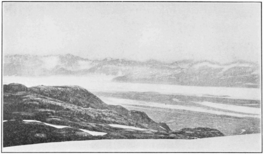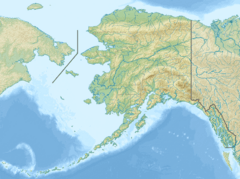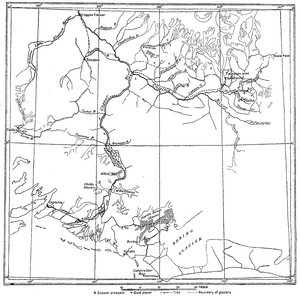Martin River Glacier facts for kids
Quick facts for kids Martin River Glacier |
|
|---|---|

Martin river glacier viewed from Mt. Chezum group. Photo dated 1911.
|
|
| Coordinates | 60°34′05″N 143°52′09″W / 60.56806°N 143.86917°W |
| Length | 25 mi (40 km) |
| Status | Retreating |
The Martin River Glacier is a huge river of ice located in Alaska, a state in the United States. It stretches about 25 miles (40 kilometers) long. This amazing glacier is found in the Yakutat-Copper River area.
Contents
Martin River Glacier: A Giant River of Ice
A glacier is like a very slow-moving river made of ice. It forms over many years as layers of snow pile up and get compressed. The Martin River Glacier is one of these incredible natural formations.
It flows towards the southwest. Its end point, called the terminus, is at the start of the Martin River. This spot is about 20 miles (32 kilometers) northeast of a place called Katalla. The glacier is nestled within the Chugach Mountains.
Where is the Martin River Glacier?
The Martin River Glacier is located in a wild and beautiful part of Alaska. This region is known for its vast landscapes and towering mountains. The glacier is part of the larger Chugach Mountains range.
These mountains are a major feature of southern Alaska. They are home to many glaciers, including the Martin River Glacier. The area is quite remote and full of natural wonders.
What is a Glacier?
Imagine a huge sheet of ice that moves very, very slowly. That's a glacier! They form in places where snow falls but doesn't melt completely in the summer. Over time, the snow gets packed down. It turns into ice under its own weight.
Glaciers can be many miles long and very thick. They slowly slide downhill due to gravity. As they move, they can carve out valleys and shape the land. They are powerful forces of nature.
Why is it Retreating?
The Martin River Glacier is currently "retreating." This means its end point is moving backwards. In other words, the glacier is getting shorter. This happens when the ice melts faster than new snow can build up and turn into ice.
Many glaciers around the world are retreating. Scientists study these changes to understand how our planet's climate is changing. The retreat of glaciers can affect local ecosystems and water supplies.



